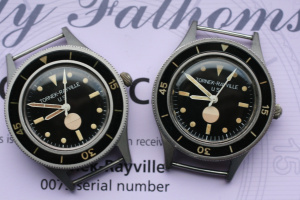Tornek-Rayville TR-900
Tornek-Rayville TR-900
A watch built by Blancpain for the United States Navy in the 1960s.
History

In the late 1950s, the U.S. Navy’s Experimental Diving Unit (NEDU) was assessing a number of "submersible wrist watches" for use by its Underwater Demolition Team divers, a unit that would later become known as the Navy SEALs. The preference was to go with an American watch company as supplier, and the Navy provided specifications to Bulova for a "standard USN watch." But while Bulova was developing that watch, NEDU decided to evaluate three commercially available dive watches to make a recommendation for use.
The rigorous tests they ran were on three watch manufacturers - a Rolex Submariner, an Enicar Sea Pearl 600, and a Blancpain Fifty Fathoms. The resulting test report (Project NS 186-200 Subtask 4, Test 43, 15 July, 1958) passed judgment on the three watches. Of the three, it was the Blancpain alone which passed with flying colors, meeting all criteria. Thus, the Blancpain was recommended for use by divers until the Bulova was ready.
The following year, the Bulova USN watch was ready for evaluation and again, NEDU conducted tests. This time, two of the three Bulovas' bezels fell off, and one stopped running. Again, the Fifty Fathoms passed the tests, and it was cheap too – a mere $55 versus $95 for the Rolex (the Enicar was $37.50 but lacked a timing bezel). But the Navy had a problem. A "Buy American Act" gave preference to American military suppliers. So an enterprising New York watch importer, Allen V. Tornek, came up with a solution. He convinced Blancpain to put "Tornek-Rayville U.S." on the dial ("Rayville" is an play on "Villeret," Blancpain’s Swiss hometown). He then marketed the watches through his US company. The Navy went with it, and the first team of Navy SEALs, established in 1962 under President John F. Kennedy, was issued the Tornek Fifty Fathoms watches.
It’s estimated that only around 1,000 Tornek-Rayville TR-900s were made, and most were subsequently destroyed. That’s because the watch made use of Promethium-147 (a radioactive element produced industrially from uranium) for its luminescent markers and hands, and the caseback gives a stern warning of its radioactivity, and the instruction, "If Found, Return to Nearest Military Facility." When these watches were decommissioned, most were disposed of, leaving an estimated 30 or less around today.
Links
- Tornek-Rayville TR-900
- Military Watches
- [[Diving Watches
- Switzerland
- Blancpain
- Main Page
Credits - https://www.hodinkee.com/articles/vintage-tornek-rayville-diving-in-depth
